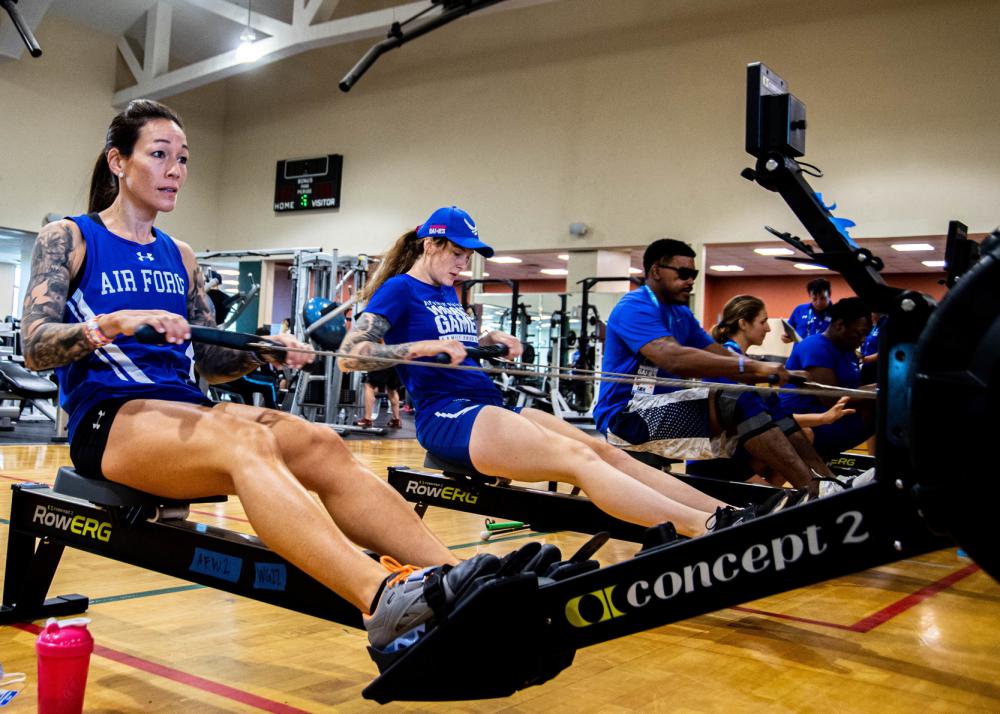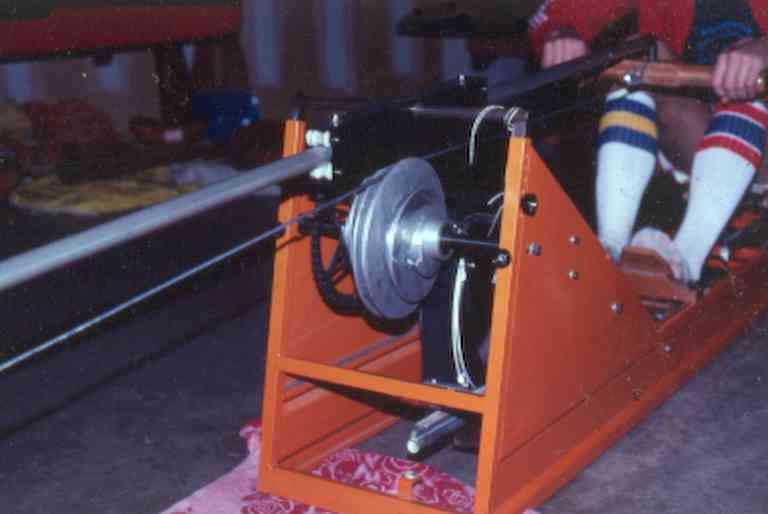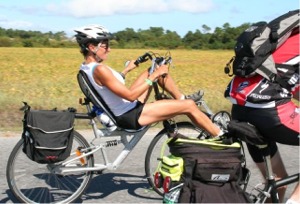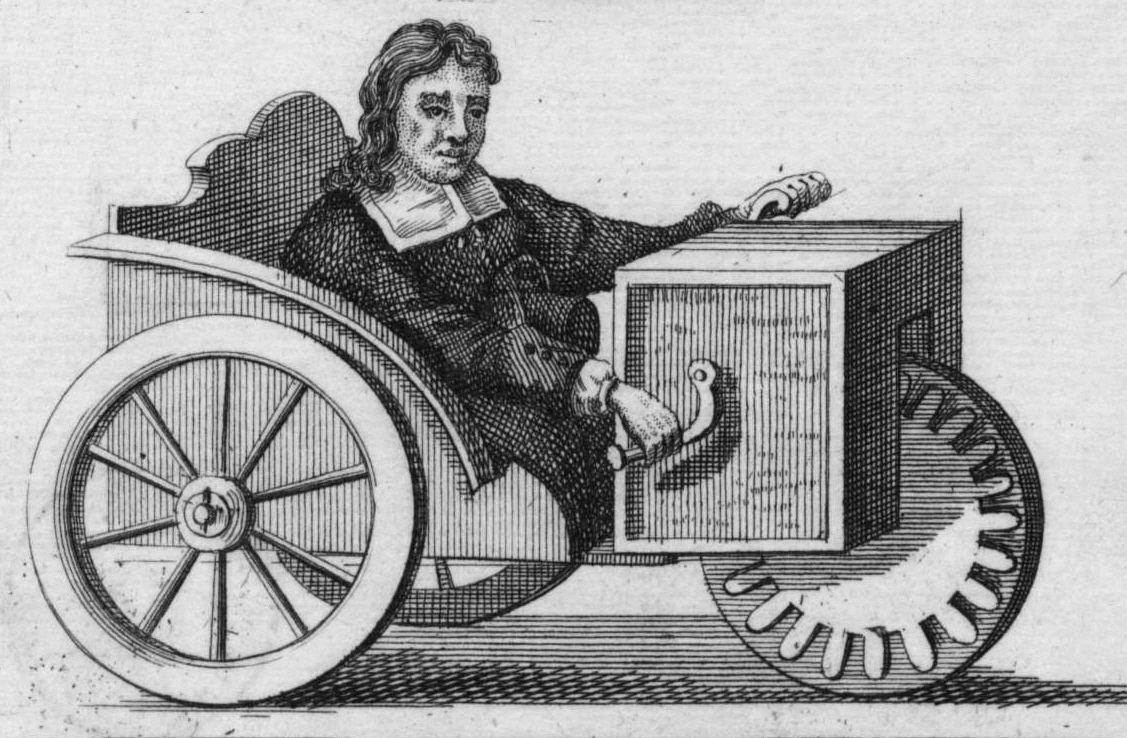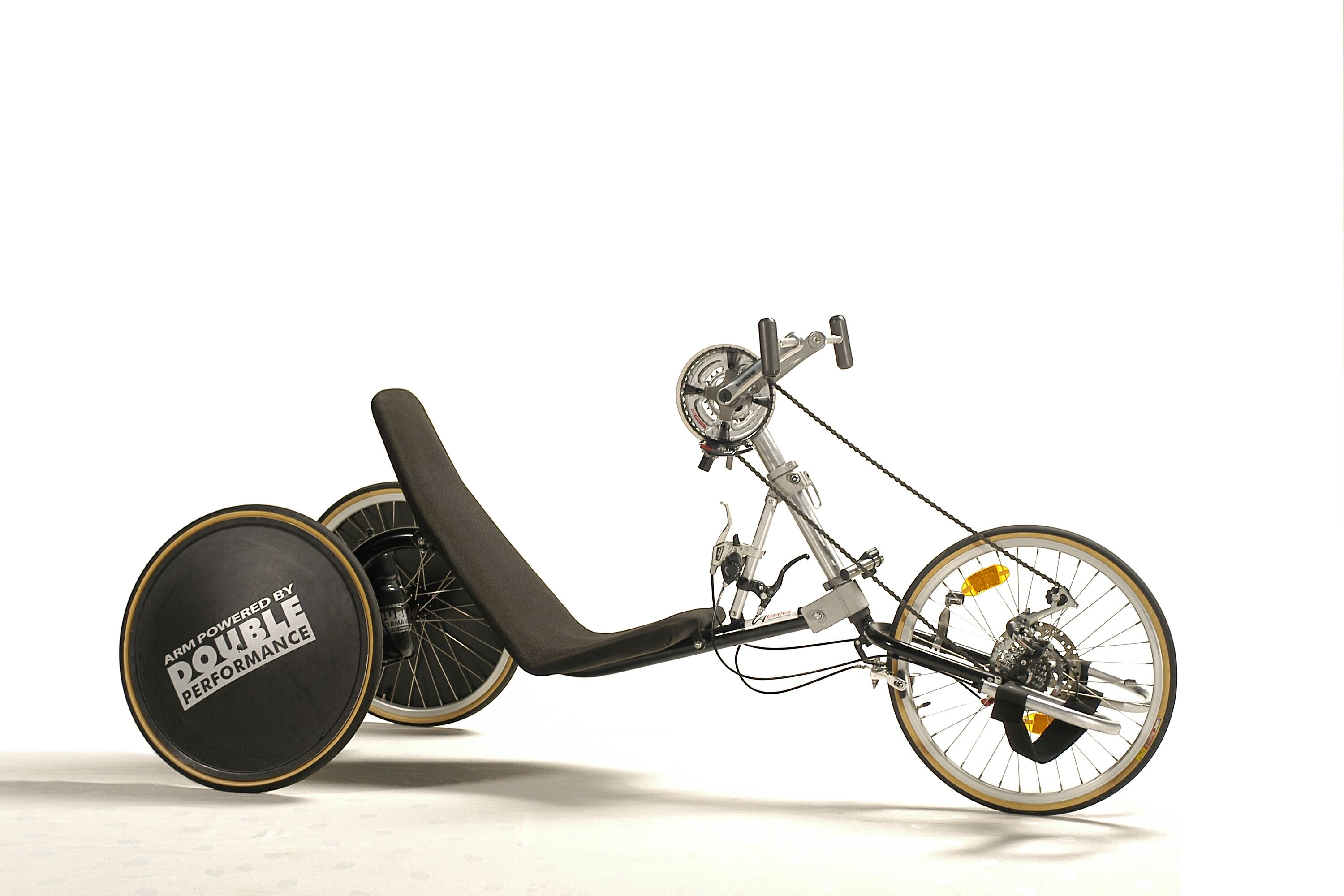|
Rowbike
A rowbike is an example of a rowing cycle, hybrid fitness/transport machine that combines a bicycle, and a rowing machine. "Rowbike" is a trademark of the Rowbike company. The Rowbike was invented by Scott Olson, the creator of Rollerblade inline skates. "Rowling" is a combination of rowing and rolling, and is sometimes used in place of rowing when describing a Rowbike. Unlike traditional bicycles, where power is supplied primarily by the rider's legs turning pedals connected to the drive wheel through a looped chain, a Rowbike delivers power through a swinging lever that moves a chain back and forth over the rear cog in a reciprocating motion regulated by a bungee cord. The rowing lever is large enough that a rider will normally utilize muscles from their legs, arms, back and abdomen to maintain a steady rowing motion to keep the Rowbike in motion. Rowbikes are marketed as providing a full body workout through the rowing motion which is gentle on the rider's knees, hips and ... [...More Info...] [...Related Items...] OR: [Wikipedia] [Google] [Baidu] |
Rowed Vehicles
A rowing cycle is a wheeled vehicle propelled by a rowing motion of the body. Steering, braking, and shifting are usually done by the handlebars. Feet are on symmetrical foot rests, as opposed to rotating pedals. Unlike many rowing boats, the rider faces forward. Rowing cycles exist in numerous designs, particularly with respect to frames and drive mechanisms. Commercial production numbers for rowing cycles are small compared to that of standard bicycles. History The use of a rowing-like action to propel a land vehicle goes probably to the 1870s, as George W. Lee used a sliding-seat in a tricycle. Roadsculler races were held in Madison Square Garden in the 1880s. A toy catalog from FAO Schwarz in 1911 advertised a four-wheeled "Row-Cycle" for children, operated using two levers in a standing position and with steering done by the feet. In the 1920s, Manfred Curry in Germany designed and constructed the Landskiff ("land boat"), a four-wheeled vehicle that would be known as a Row ... [...More Info...] [...Related Items...] OR: [Wikipedia] [Google] [Baidu] |
Quadracycle (human-powered Vehicle)
A quadracycle (also spelled quadricycle) is a four-wheeled human-powered land vehicle. It is also referred to as a quadcycle, pedal car or four-wheeled bicycle amongst other terms. Quadracycles have been in use since 1853 and have grown into several families of vehicles for a variety of purposes, including tourist rentals, pedal taxis, private touring, mountain and industrial use. Nomenclature There is no consensus amongst manufacturers of four-wheeled, human-powered vehicles as to what this class of vehicles should be called, although ''quadracycle'' is the most commonly used term. Manufacturers who do refer to their products by class of vehicle call them: *Quadracycle - 11 manufacturers *Four-wheel bicycle - 7 manufacturers *Quadricycle - 5 manufacturers *Quadcycle - 3 manufacturers *Pedal car - 2 manufacturers *Quad - 2 manufacturers In addition there are single manufacturers who call them Go-kart, Car, Car-Bike, Ecological car, Human Powered Vehicle, Pedal Kart, Quadri ... [...More Info...] [...Related Items...] OR: [Wikipedia] [Google] [Baidu] |
Indoor Rower
An indoor rower, or rowing machine, is a machine used to simulate the action of watercraft rowing for the purpose of exercise or training for rowing. Modern indoor rowers are known as ergometers (colloquially erg or ergo) because they measure work performed by the rower (that can be measured in ergs). Indoor rowing has become established as a sport, drawing a competitive environment from around the world. The term "indoor rower" also refers to a participant in this sport. History Chabrias, an Athenian admiral of the 4th century BC, introduced the first rowing machines as supplemental military training devices. "To train inexperienced oarsmen, Chabrias built wooden rowing frames onshore where beginners could learn technique and timing before they went onboard ship." Early rowing machines are known to have existed from the mid-1800s, a US patent being issued to W.B. Curtis in 1872 for a particular hydraulic-based damper design. Machines using linear pneumatic resistance were ... [...More Info...] [...Related Items...] OR: [Wikipedia] [Google] [Baidu] |
Rowing Machine
An indoor rower, or rowing machine, is a machine used to simulate the action of watercraft rowing for the purpose of exercise or training for rowing. Modern indoor rowers are known as ergometers (colloquially erg or ergo) because they measure work performed by the rower (that can be measured in ergs). Indoor rowing has become established as a sport, drawing a competitive environment from around the world. The term "indoor rower" also refers to a participant in this sport. History Chabrias, an Athenian admiral of the 4th century BC, introduced the first rowing machines as supplemental military training devices. "To train inexperienced oarsmen, Chabrias built wooden rowing frames onshore where beginners could learn technique and timing before they went onboard ship." Early rowing machines are known to have existed from the mid-1800s, a US patent being issued to W.B. Curtis in 1872 for a particular hydraulic-based damper design. Machines using linear pneumatic resistance were co ... [...More Info...] [...Related Items...] OR: [Wikipedia] [Google] [Baidu] |
Indoor Rower
An indoor rower, or rowing machine, is a machine used to simulate the action of watercraft rowing for the purpose of exercise or training for rowing. Modern indoor rowers are known as ergometers (colloquially erg or ergo) because they measure work performed by the rower (that can be measured in ergs). Indoor rowing has become established as a sport, drawing a competitive environment from around the world. The term "indoor rower" also refers to a participant in this sport. History Chabrias, an Athenian admiral of the 4th century BC, introduced the first rowing machines as supplemental military training devices. "To train inexperienced oarsmen, Chabrias built wooden rowing frames onshore where beginners could learn technique and timing before they went onboard ship." Early rowing machines are known to have existed from the mid-1800s, a US patent being issued to W.B. Curtis in 1872 for a particular hydraulic-based damper design. Machines using linear pneumatic resistance were ... [...More Info...] [...Related Items...] OR: [Wikipedia] [Google] [Baidu] |
Recumbent Bicycle
A recumbent bicycle is a bicycle that places the rider in a laid-back reclining position, and often called a Human-powered_land_vehicle, human-powered vehicle or HPV, especially if it has an aerodynamic fairing. Recumbents are available in a wide range of configurations, including: long to short wheelbase; large, small, or a mix of wheel sizes; overseat, underseat, or no-hands steering; and rear wheel or front wheel drive. A variant with three wheels is a recumbent tricycle, with four wheels a quadracycle. Recumbents can be faster than upright bicycles, but they were banned by the Union Cycliste Internationale (UCI) in 1934. Recumbent races and records are now overseen by the World Human Powered Vehicle Association (WHPVA), International Human Powered Vehicle Association (IHPVA) and World Recumbent Racing Association (WRRA). Some recumbent riders may choose this type of design for ergonomic reasons: the rider's weight is distributed comfortably over a larger area, supported by ... [...More Info...] [...Related Items...] OR: [Wikipedia] [Google] [Baidu] |
Rowing Equipment
Rowing, often called crew American English, in the United States, is the sport of racing boats using Oar (sport rowing), oars. It differs from paddling sports in that rowing oars (called blades in the United Kingdom) are attached to the boat using Rowlock, rowlocks, while paddles are not connected to the boat. Rowing is divided into two disciplines: sculling and sweep rowing. In sculling, each rower (or oarsman) holds two oars, one in each hand, while in sweep rowing each rower holds one oar with both hands. There are several boat classes in which athletes may compete, ranging from single sculls, occupied by one person, to shells with eight rowers and a coxswain (rowing), coxswain, called eight (rowing), eights. There are a wide variety of course types and formats of racing, but most elite and championship level racing is conducted on calm water courses long with several lanes marked using buoys. Modern rowing as a competitive sport can be traced to the early 17th century whe ... [...More Info...] [...Related Items...] OR: [Wikipedia] [Google] [Baidu] |
Tricycle
A tricycle, sometimes abbreviated to trike, is a Human-powered transport, human-powered (or gasoline or electric motor powered or assisted, or gravity powered) Three-wheeler, three-wheeled vehicle. Some tricycles, such as cycle rickshaws (for passenger transport) and freight trikes, are used for commercial purposes, especially in the developing world, particularly Africa and Asia. In the West, adult-sized tricycles are used primarily for recreation, shopping, and exercise. Tricycles are favoured by children, the disabled, and senior adults for their apparent stability versus a bicycle; however a Three-wheeler#Two rear, conventional trike may exhibit poor dynamic lateral stability, and the rider should exercise appropriate operating caution when cornering (e.g., with regard to speed, rate of turn, slope of surface) and operating technique (e.g., leaning the body 'into' the turn) to avoid tipping the trike over. Designs such as recumbents or others which place the rider lower relat ... [...More Info...] [...Related Items...] OR: [Wikipedia] [Google] [Baidu] |
Handcycles
A handcycle is a type of human-powered land vehicle powered by the arms rather than the legs, as on a bicycle. Most handcycles are tricycle in form, with two coasting rear wheels and one steerable powered front wheel. Despite usually having three wheels, they are also known as ''handbikes''. History Stephan Farffler was a Nuremberg watchmaker of the seventeenth century whose invention of a manumotive carriage in 1655 is widely considered to have been the first self-propelled bicycle. He is believed to have been either a paraplegic or an amputee. The three-wheeled device is believed to have been a precursor to the modern-day tricycle and bicycle. Later innovations in handcycle design would be driven by a need to provide transportation for soldiers injured during the American Civil War, and later, the First World War. While Farffler's carriage emerged from his background as a clockmaker, mid-nineteenth century designs would be produced by mainstream bicycle manufacturers such ... [...More Info...] [...Related Items...] OR: [Wikipedia] [Google] [Baidu] |
Newsreel
A newsreel is a form of short documentary film, containing news, news stories and items of topical interest, that was prevalent between the 1910s and the mid 1970s. Typically presented in a Movie theater, cinema, newsreels were a source of current affairs, information, and entertainment for millions of moviegoers. Newsreels were typically exhibited preceding a feature film, but there were also dedicated News cinema, newsreel theaters in many major cities in the 1930s and ’40s, and some large city cinemas also included a smaller theaterette where newsreels were screened continuously throughout the day. By the end of the 1960s News broadcasting, television news broadcasts had supplanted the format. Newsreels are considered significant historical documents, since they are often the only audiovisual record of certain cultural events. History Silent news films were shown in cinemas from the late 19th century. In 1909 Pathé started producing weekly newsreels in Europe. Pat ... [...More Info...] [...Related Items...] OR: [Wikipedia] [Google] [Baidu] |
